
A Short History of Transporter Bridges
An eBook by Cyril J Wood


The transporter bridge was born out of the need to cross rivers or waterways were it was inconvenient (or too expensive) to build conventional high-level bridges with sufficient navigable air-draft (headroom) to accommodate the masts and tall funnels/superstructure of vessels using the waterways to be crossed.
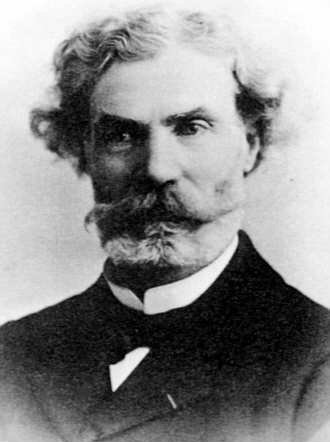
Monsieur Ferdinand Arnodin
There are twenty two transporter bridges mentioned in this text. There may have been more but details of their existence is not generally available. Of those constructed around the world, only nine still exist and fewer are still in regular use. The World's first Transporter Bridge, near Bilbao, Spain, opened in 1893 and is still in regular daily use. Most of the bridges were constructed in the twenty-three year period between 1893 and 1916 (not including reconstructions and a couple of later examples) and of the eleven demolished structures an average life of thirty-six years was achieved. It is interesting to note that most of the bridges had some form of involvement from Monsieur Ferdinand Arnodin. Arnodin was renowned as one of the world’s foremost authorities on transporter bridges even though he was pre-dated in his ideas by nearly twenty years by Mr. Charles Smith whose plans for the Middlesbrough Transporter Bridge were submitted in 1872. Accordingly, it is not surprising that the greatest concentration of transporter bridges, or as they are sometimes known… “Aerial Ferries” appears to be in France. Even so, there were once five examples throughout the United Kingdom (with one more to come).
A transporter bridge usually consists of a framework of steel girders spanning the river or waterway to be crossed. Instead of a roadway or railway lines built on a deck spanning the gap, a platform or "gondola" is usually suspended by steel cables (although a couple of examples feature the gondola suspended by fixed girders) from a moveable trolley running across the top of the span on a track. The trolley moves across the span on the track taking with it the gondola, onto which are loaded the passengers and vehicles.
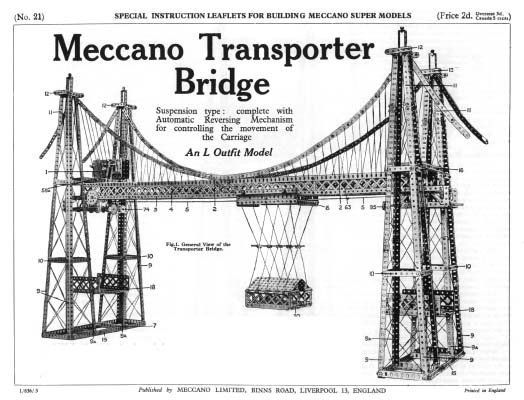
A plan for a "Meccano" model transporter bridge
These once popular forms of crossing waterways have fallen out of popularity with three examples remaining in this country, of which only two are in working order. However, a new footbridge across the Royal Victoria Dock in London has been constructed with the capability of being converted into a transporter bridge at a later date. The bridge will, at first, be a conventional pedestrian footbridge and if the proposed development nearby goes ahead, the 200 mtr long footbridge will be converted into a small transporter bridge with an enclosed gondola or capsule.
The twenty two examples of transporter bridges throughout the World, listed in approximate chronological order of construction are...
|
1 |
1893 - Bilbao (Spain) - In regular daily use |
|
2 |
1898 - Rouen (France) - Demolished |
|
3 |
1898 - Bizerta (Tunisia) - Dismantled and reconstructed at Brest |
|
4 |
1900 - Rochefort-Martrou (France) - In regular use |
|
5 |
1903 - Crosfields No1 (Warrington) spanning the River Mersey - Demolished |
|
6 |
1903 - Nantes (France) - Demolished |
|
7 |
1905 - Runcorn-Widnes spanning the River Mersey - Demolished |
|
8 |
1905 - Marseilles (France) - Demolished |
|
9 |
1905 - Duluth Aerial Bridge (USA) - Reconstructed as a lift-bridge |
|
10 |
1906 - Newport spanning the River Usk - In regular daily use |
|
11 |
1909 - Brest (France) - Demolished |
|
12 |
1909 - Osten (Germany) - In regular use |
|
13 |
1910 - Kiel (Germany) - Demolished |
|
14 |
1910 - Bordeaux (France) - Not completed - Demolished |
|
15 |
1911 - Middlesbrough spanning the River Tees - In regular daily use |
|
16 |
1912 - Crosfields No2 (Warrington) spanning the River Mersey - In need of restoration |
|
17 |
1913 - Rendsburg (Germany) - Used occasionally |
|
18 |
1914 - Buenos Aires (Argentina) - In regular use |
|
19 |
1915 - Rio de Janeiro (Brazil) - In need of restoration |
|
20 |
1933 - Chicago Sky Ride (USA) - Demolished |
|
21 |
1955 - Stalingrad (now Volgograd, Russia) - Dismantled |
| 22 | 1998 - Royal Victoria Dock (London) - Not yet completed |
|
In addition to the bridges listed above there were bridges planned at the following locations but were never constructed... |
|
| Across the sandbanks between Poole and Swanage, Dorset, England. | |
| Across the River Ribble Estuary, Preston, Lancashire, England. | |
| From Easthey to Hayling Island, Hampshire, England. | |
|
Across the River Seine at Tancarville below Rouen, France. |
|
|
Across the River Liffey at Dublin, Ireland |
|
1893 - Bilbao (Spain) Transporter Bridge
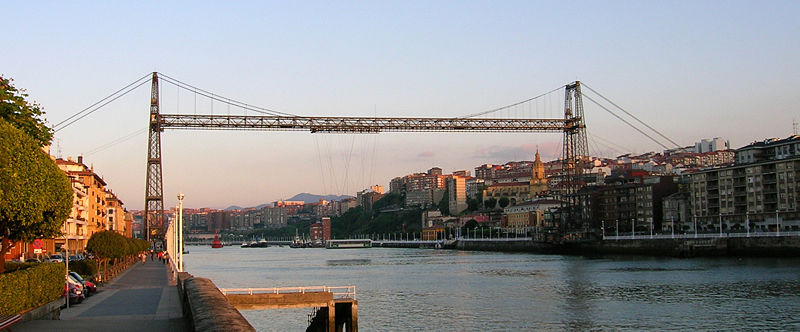
The Bilbao Transporter Bridge spanning the Nervión River
The 165 mtr Bilbao Transporter Bridge was constructed in 1893 which makes it the first bridge of this kind to have been built. Designed by Alberto Palacio, one of Gustave Eiffel's disciples it spans the mouth of the Firth of Nervión (Nervión River) linking the towns of Portugalete and Las Arenas (neighbourhoods of Getxo) in the Biscay province of Spain.

The Bilbao Transporter Bridge's gondola
The bridge is called locally “Puente Colgante” which roughly translated means “Suspension Bridge” after the previous bridge which was of the suspension design. The existing bridge is a reconstruction of the original. The reconstruction was undertaken by J. Juan Aracil between 1939 and 1941.The bridge is in regular daily use and operates every 8 minutes, 24 hours a day all year round. There are different fares depending on the time of day, the bridge is integrated into Bilbao's Creditrans transport system and its gondola can transport six cars and several dozen passengers across the river in one and a half minutes. The service was only interrupted for four years during the Spanish Civil War when the upper section was dynamited. From his house in Portugalete, Alberto Palacio could see how his master work was partially destroyed just before his own death. There are two new visitors lifts installed in the 50 mtr high pillars of the bridge that allow brave visitors that do not suffer from vertigo to walk over the bridge's platform, from where they can see the port and the Abra Bay. On 13th July 2006 it was declared a World Heritage Site by UNESCO.
1900 - Rochefort-Martrou (France) Transporter Bridge
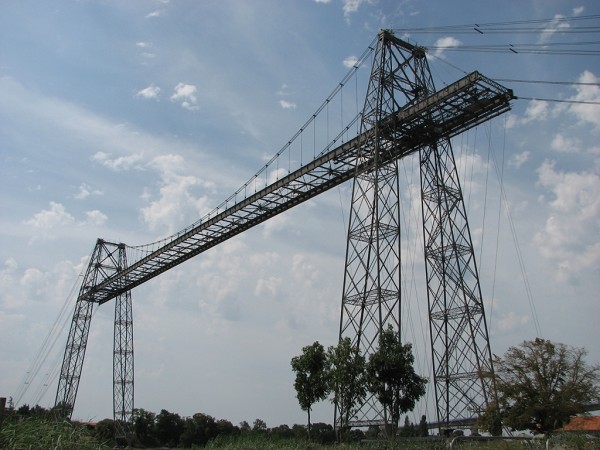
The Rochefort-Martrou Transporter Bridge spanning the River Charente
The Rochefort-Martrou Transporter Bridge was constructed by Ferdinand Arnodin to cross the River Charente. It came into service on 8th July 1900 at a cost of 586599 French Francs. It has a span of 139.916 mtrs and is 59 metres in height. The deck beams and suspension were replaced and modified between 1933 and 1934. The bridge came out of service in 1967 when it was superseded by a nearby vertical lift bridge. On the 30th April 1976 it was classified as a historic monument and refurbished in 1996. It is still in use today and is a tourist attraction.
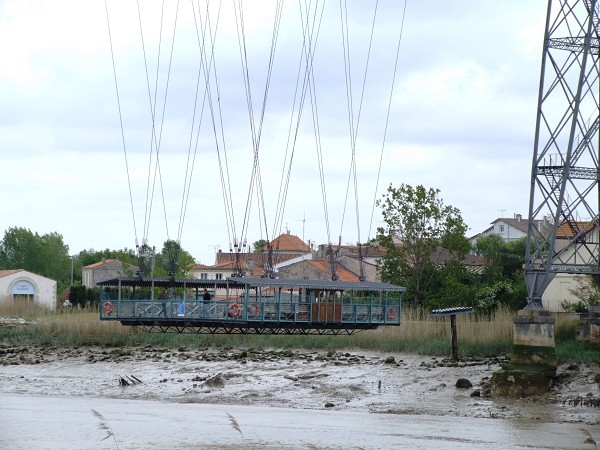
The gondola of the Rochefort-Martrou Transporter Bridge
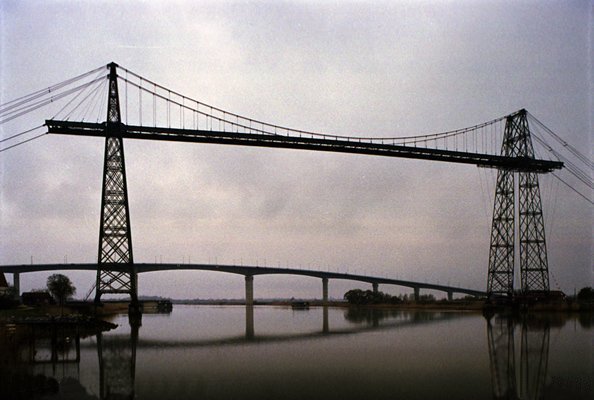
The Rochefort-Martrou Transporter Bridge alongside a modern concrete road viaduct
1898 - Rouen (France) Transporter Bridge
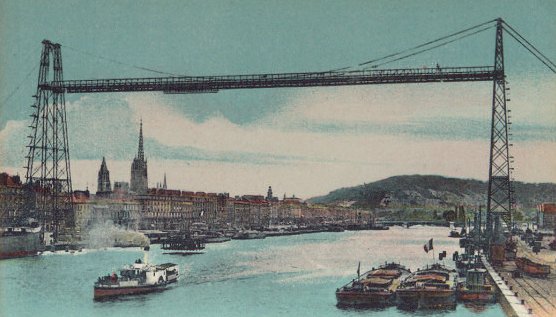
The Rouen Transporter Bridge spanning the Seine
The Rouen Transporter Bridge, constructed by Ferdinand Arnodin in 1898, spanned the Seine. It had a span of 142 mtrs and a pylon height of 70 mtrs. The bridge was destroyed on 9th September 1940 by the French Army to stall the advance of the German troops.
1898 - Bizerta (Tunisia) Transporter Bridge
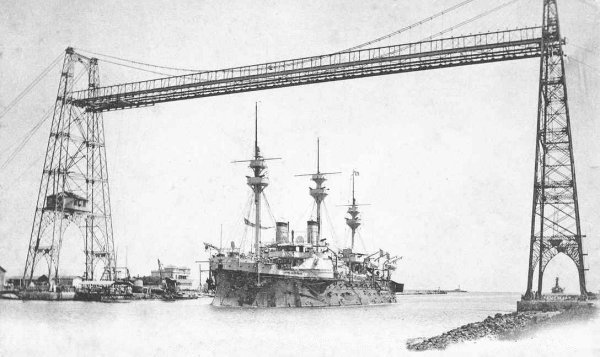
The Bizerta Transporter Bridge spanned the canalised entrance to Lake Bizerta
Ferdinand Arnodin had to travel a little further afield when he designed and built the Bizerta Transporter Bridge in Tunisia. It had a span of 109 mtrs and crossed the canalised entrance to Lake Bizerta. In 1909 it was dismantled and reconstructed at Brest in France.
1902 - Crosfields Number One (Bank Quay - Warrington) Transporter Bridge
In 1814 Joseph Crosfield started manufacturing soap in a factory located on the banks of the tidal River Mersey at bank Quay near Warrington. The factory was expanded to produce candles and other chemicals. In 1911 the company was purchased by the Brummer, Mond and Company and in 1919 became part of the Lever Brothers - later Unilever empire (and their original factory). Situated at Bank Quay near Warrington in Cheshire it was constructed on the banks of the tidal River Mersey as it meandered its way to Warrington town centre.
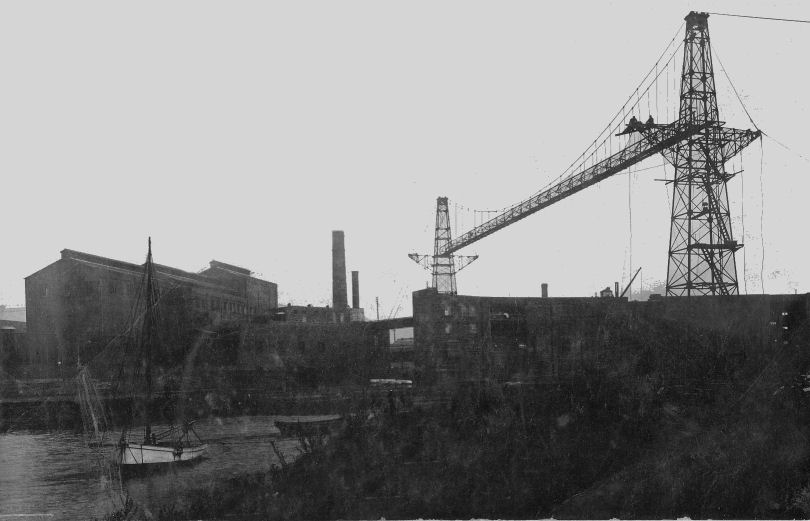
The original Crosfields Number One Transporter Bridge
As time went on, the plant expanded across the Mersey and in 1902 a transporter bridge was constructed to carry railway trucks vehicles across the river to various parts of the complex. This bridge was complemented by a later bridge built to the cantilever design with a suspended, electrically operated platform in 1912 that, as well as transporting railway trucks could also accommodate road vehicles and the first bridge was later demolished.
1903 - Nantes (France) Transporter Bridge
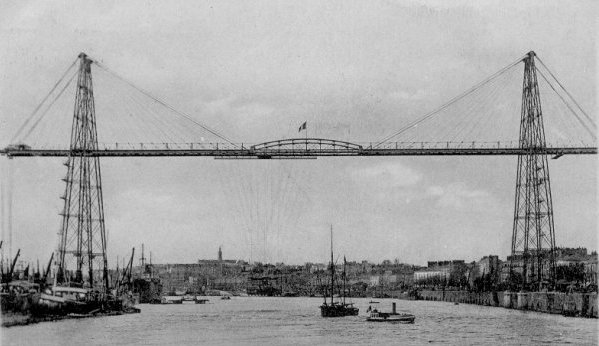
The Nantes Transporter Bridge spanned the River Loire
Another of Ferdinand Arnodin’s bridges was at Nantes in France in 1903. The bridge had a span of 141 mtrs across the River Loire and was demolished during the Second World War. Unfortunately, little information is available about this bridge.
1905 - Runcorn-Widnes Transporter Bridge
The Widnes-Runcorn Transporter Bridge was opened on 29th May 1905 to replace the previous ferry and to supplement the toll footbridge that ran beside the high-level Victoria Railway Viaduct across the River Mersey and the Manchester Ship Canal.

An original diagram of the Runcorn-Widnes Transporter Bridge
A transporter bridge consists of a high-level gantry along which a wheeled trolleys move. Beneath the trolley is suspended a cargo-carrying platform or gondola, which travels at ground level. Traffic enters the platform at one side of the bridge, and the mobile trolley carries it to the other side. The transporter design was chosen here because the Manchester Ship Canal, running alongside the River Mersey at Runcorn, carried tall ocean-going ships, which a low-level bridge would have obstructed. At the time, the expense and engineering complexity of a high-level road bridge was prohibitive, although the high-level Victoria Railway Viaduct had been constructed in 1868. The total cost of the Transporter Bridge was £130,000, about one third of that of a high-level bridge.

A view of the bridge from beside the railway bridge on the Widnes bank of the River Mersey
The bridge was a magnificent feat of Edwardian engineering. The span of the bridge across the Mersey was 1000 feet (305 mtrs) making it the longest span of any transporter bridge anywhere in the World at the time. The bridge towers stood 190ft (58 mtrs) above high water, and the main cables supporting the bridge, which was of the suspension type, were 12ins (300mm) thick. However, the suspended car was very sensitive to adverse weather, and the bridge would often be closed down in high winds.
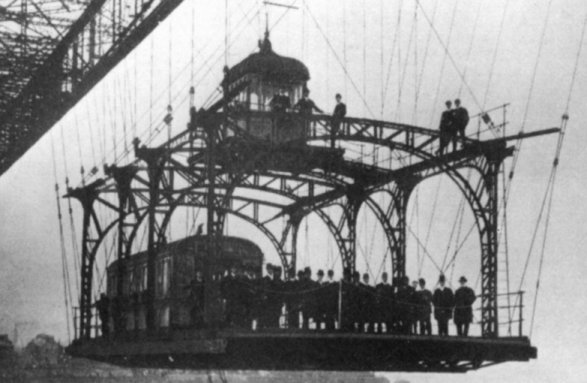
The Runcorn-Widnes Transporter Bridge gondola
Widnes Corporation had a controlling interest in the bridge, and as the operators of the bus department, arranged a fairly integrated transport service, with a Corporation bus stop only yards away from the bridge ticket office. The bus service on the Runcorn side was privately operated, and not so well integrated… the nearest bus stop was about a mile from the bridge.

All three Runcorn Bridges can be seen in this rare aerial photograph taken in 1961
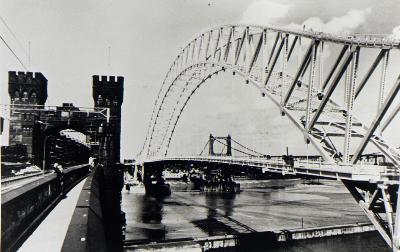
All three Runcorn Bridges are also visible in this photograph from the Runcorn bank of the River Mersey
The most prestigious passengers on the bridge were King George V, in 1925, and Queen Elizabeth, the Queen Mother, who visited in 1958. The domes on top of the towers were especially painted for the latter occasion, even though it was known that the bridge had only three years of life remaining.
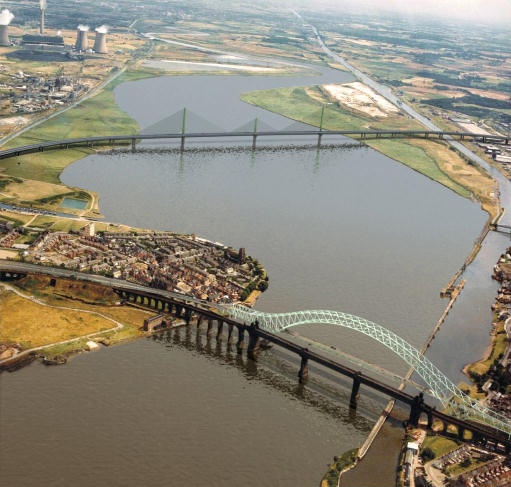
This aerial view shows the present day bridges at Runcorn Gap and the new Mersey Gateway Bridge...
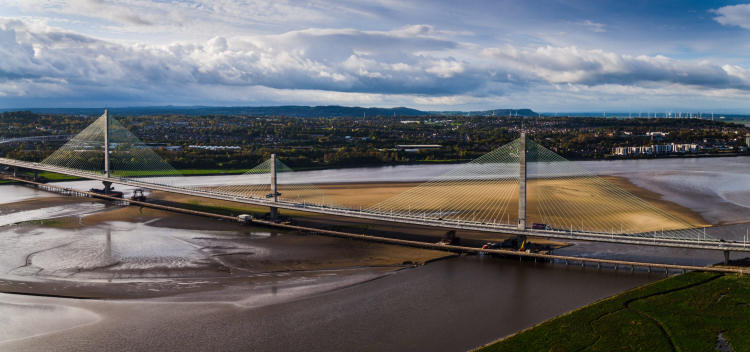
... and the new Mersey Gateway Bridge from the opposite direction
A high-level road bridge was finally built and known as the Silver Jubilee Bridge. It was opened by Princess Alexandra on 21st July 1961, and the Transporter Bridge was closed the next day. It was scheduled for demolition almost immediately. The 1961 road bridge was the longest span in Europe at the time of construction and was supplemented by another high-level bridge about a mile upstream. The modern cable stayed design of the new bridge known as the “Mersey Gateway Bridge” which opened for traffic in 2019 and a previous design incorporated a light railway suitable for trams on a second deck beneath the roadway platform.
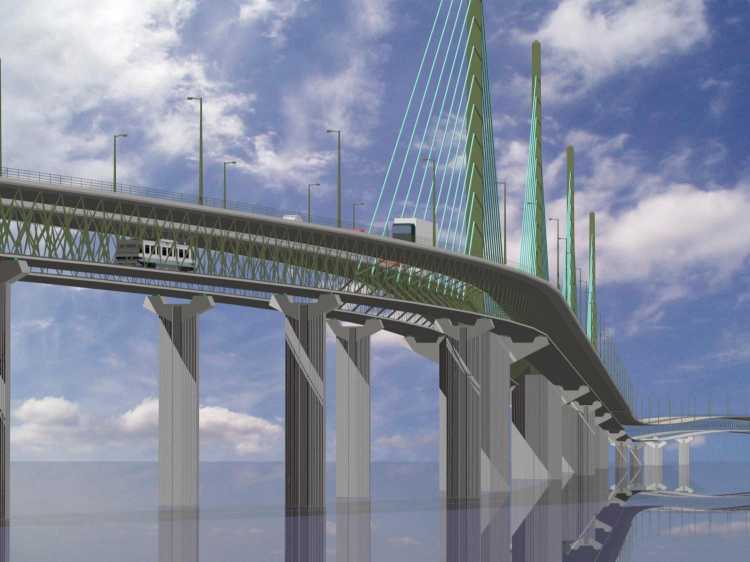
A computer generated image of an earlier design of the Mersey Gateway Bridge
(Note the light railway beneath the main carriageway deck)
Very little is now left to show that the transporter bridge ever existed. There is a short pier on the Widnes side that was originally the bridge approach road and a similar pier complete with commemoration plaque on the Runcorn side. There is also a modern pub in Runcorn called “The Old Transporter” which is decorated with pictures and memorabilia of the bridge.
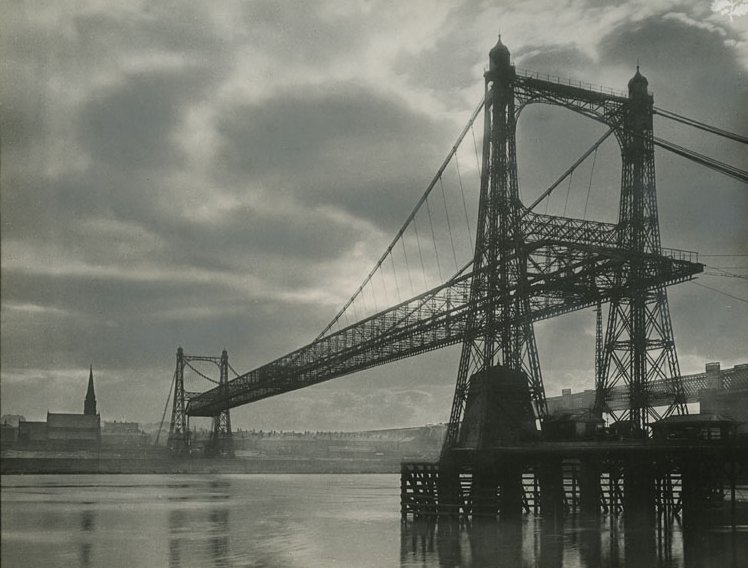
A beautiful, moody Chambre Hardman photograph of the Runcorn-Widnes Transporter Bridge
1905 - Marseilles (France) Transporter Bridge
Ferdinand Arnodin constructed this transporter bridge over the “Viex Port” in Marseilles, France between 1904 and 1905. The bridge was opened on 24 December 1905 had a span of 165 mtrs and a pylon height of 80 mtrs.
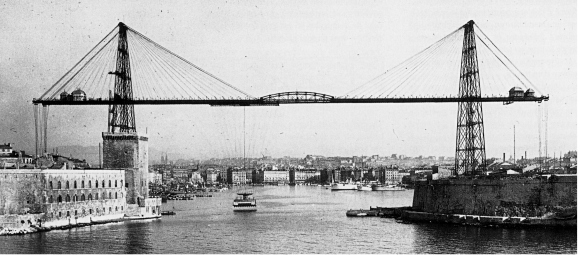
The Marseille Transporter Bridge spanned the "Viex Port"
The fast-opening parachute was demonstrated on 7th October 1934 by throwing a dummy off the platform of the bridge into the waters of the “Viex Port” below. During the Second World War, on 22nd August 1944, the northern tower was dynamited by German troops effectively demolishing the bridge which was not rebuilt.
1905 - Duluth Aerial Bridge
The Aerial Lift Bridge (previously known as the Aerial Bridge or Aerial Ferry Bridge) is a major landmark in the port city of Duluth, Minnesota, U.S.A. The span is a vertical lift bridge, which is rather uncommon, but it began life as a transporter bridge, the first of just two such bridges ever constructed in the United States. Originally built in 1905, the bridge was upgraded in 1929–30 to the current lifting design and continues to operate today. The bridge was added to the National Register of Historic Places on 22nd May 1973 and maritime museum maintained by the US Army Corps of Engineers exists near the site of the bridge.

The Duluth Transporter spans a canal at the mouth of the St Louis River
The bridge spans a small canal that was put through the thin but long sand bar named Minnesota Point (commonly referred to as Park Point by locals) in 1870–71. The natural mouth of the St. Louis River is about seven miles (11 km) farther southeast, and is split between Minnesota and Wisconsin. Creating this gap in the tiny peninsula meant that residents who lived on the new island needed to have a way to get across. Several different transportation methods were tried, though they were complicated by the weather. Ferries could work in the summer, but ice caused problems in colder months. A swinging footbridge was used, but was considered rather rickety and unsafe.
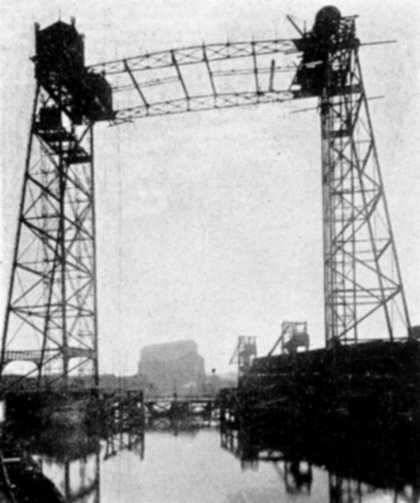
The South Halsted Street Vertical Lift Bridge in Chicago Illinois
In 1892, a contest was held to find a solution. The winning design came from John Alexander Low Waddell, who drew up plans for a high-rise vertical lift bridge. The city of Duluth was eager to build the bridge, which would have been about 130 feet (40 mtrs) wide. However, the War Department objected to the design, and the project was cancelled before it could be built. Waddell's design went on to be built in Chicago, Illinois as the slightly larger South Halsted Street Bridge. New plans were later drawn up for a structure that would ferry people from one side to the other. This type of span, which is known variously as an aerial transfer, ferry, or transporter bridge, had first been demonstrated in Bilbao's Vizcaya Bridge in 1893 and one in France in 1898. Duluth's bridge was inspired by the one in France, though the actual construction is quite different. The architect was a city engineer, Thomas McGilvray.

A rare hand-tinted photograph of the Duluth Transporter Bridge
When it was completed in 1905, the Aerial Bridge's gondola had a capacity of 60 short tons (54 tonne) and could carry 350 people plus wagons, streetcars, or automobiles. A trip across the canal took about one minute, and the ferry car traversed once every five minutes during busy times of the day. However, a growing population on Minnesota Point, a greater demand for cars, and an increase in tourism soon meant that the bridge's capacity was being stretched to the limit. A remodelling was planned that would incorporate a lifting platform into the structure. Ironically, the firm finally commissioned with designing the new bridge was the descendant of Waddell's company. The design is attributed to C.A.P. Turner.
In order to ensure that tall ships could still pass under the bridge, the top span had to be raised to accommodate the new deck when raised. The support columns on either side were also modified so that they could hold new counterweights to balance the weight of the lifting portion. The new design closely resembled the original concept put forth in 1892. The modern structure went into operation on 19th March 1930.
The bridge can be raised to its full height in about 3 minutes, and goes up 25 to 30 times daily during busy parts of the shipping season. The span is about 390 feet, or 120 mtrs.
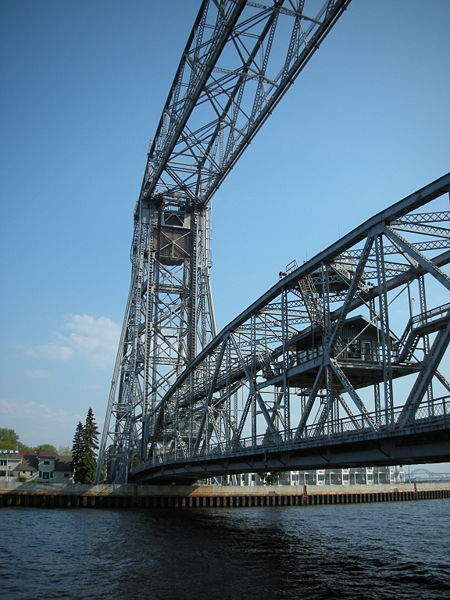
The Duluth bridge in more recent times after conversion to a lift bridge
The canal that runs under the bridge has quite a story of its own. Construction began in 1870, but became a contentious issue with the neighbouring port of Superior, Wisconsin. The city of Superior even went to federal court to halt the construction. An injunction to stop work sat waiting to be served one weekend in 1871, so an army of 50 volunteers was quickly dispatched by Duluth's administrators to the canal site so it could be completed before Monday rolled around. They succeeded in creating a 30 foot (9 mtrs) wide channel, essentially making the injunction meaningless. Interestingly, the man who owned the land where the channel went in was Wilhelm Boeing. He didn't appreciate the canal and, for a time tried to stop ships from travelling into the port by that route. Eventually he gave up and moved to Seattle, Washington, where his son went on to found the Boeing aircraft company.
1906 - Newport Transporter Bridge
The Newport Transporter Bridge, first opened in 1906, is a steel hybrid suspension/cable stayed bridge near the mouth of the River Usk. An important and historic Grade I Listed Building, it is currently one of only two working transporter bridges in the British Isles, and of the seven that have survived out of fifteen originally built world wide. The bridge stands some 75 mtrs tall with a clear span of 197 mtrs. Even though it has a reasonably short span it is, nonetheless an important example of Victorian engineering. The Bridge has been both loved and loathed by many over its 90 year life, but the importance of this unusual structure cannot be denied and is recognized by the Grade I Listed building status conferred on it following its refurbishment. Essentially an aerial ferry and originally designed to carry two four-wheeled vehicles, each with axle loads of 7·5 tonnes the bridge is today capable of carrying up to six light road vehicles and 120 pedestrians across the river Usk at 15 min. intervals. Approximately 100 years ago French suspension bridge expert Ferdinand Arnodin was commissioned to design the Newport Transporter Bridge in south Wales, one of the world’s few surviving aerial ferries. This rare and unusual bridge, which uses both cable-stayed and parabolic suspension systems shows that Arnodin was right at the cutting edge of civil engineering development at the beginning of the last century.
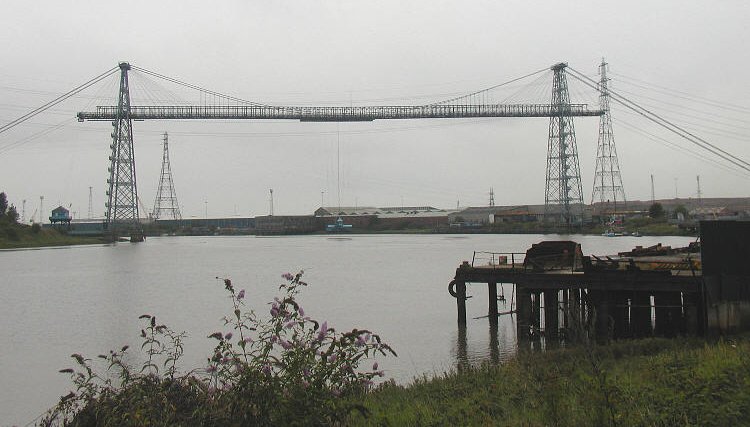
The Newport bridge with the gondola mid-way across the River Usk
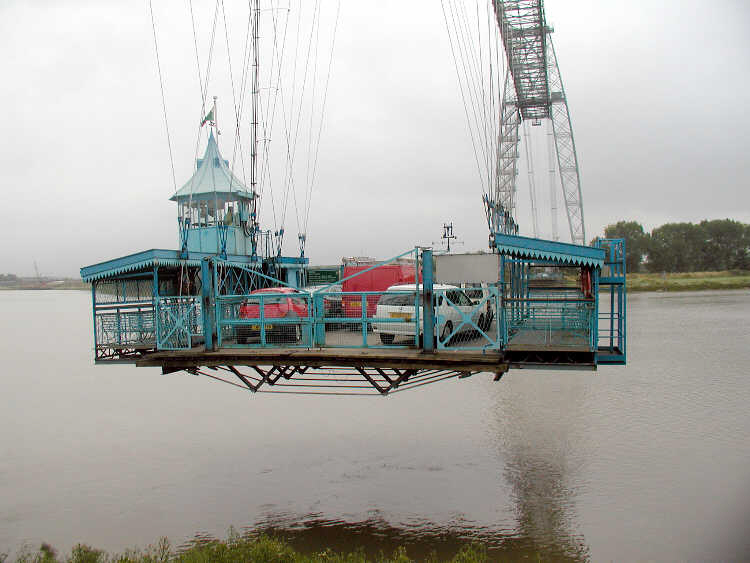
A closer view of the gondola
Background
The town of Newport in south Wales is divided into two parts by the relatively wide, swiftly flowing River Usk, renowned for its exceptionally high tides. The Usk at Newport has been crossed at the northern end of the town from as early as the 12th century, and the adequacy of the Town Bridge was frequently being questioned. It was widened in 1866 and then partly reconstructed in 1892 - 1893 following the rapid development of the east bank of the river along the then new Corporation Road. Between 1869 and 1889, various schemes were proposed for joining the two sides of the river at the southern end of the town but, although a ferry and foot-passenger subway were authorized, the latter was never started because of a lack of finance and the former ended following a number of fatalities on what was undoubtedly an extremely risky crossing. In 1896 John Lysaght of Wolverhampton announced his intention to build a steelworks in the south west and, so as to attract him to a site on the east bank of the river, proposals for a crossing were again resurrected. Tunnels and high-level bridges were rejected for financial reasons, and traditional moving bridges were considered unsuitable because of the obstruction they offered to the free use of the waterway. The borough engineer of Newport, R. H. Haynes, had however heard of the work of the French engineer Ferdinand Arnodin and his "Aerial Ferries", which appeared to meet Newport’s needs. This was therefore the proposal and, following a visit to Rouen to inspect a similar Transbordeur designed by Arnodin, the borough elected to proceed without delay. Parliamentary approval was obtained in 1900; Haynes and Arnodin were appointed joint engineers and detailed design was undertaken during 1901. In 1902 a contract was let to Alfred Thorne of Westminster and the bridge was opened on 12th September 1906 by Viscount Tredegar at a cost of £98,124.
General Specifications
At a maximum speed of 11 km/h, journey time for the 196·6 mtrs crossing is typically about 5 min and operations are only suspended if winds exceed gale force 6 (50 km/h). The height to the underside of the boom is 53·95 mtrs and the towers reach a further 19·65 mtrs above the boom. The gondola measures 10 mtrs long by 12·2 mtrs wide and is suspended by cables from a high-level travelling frame. This spreads the live load over a 32 mtr length of the stiffening boom which, in the central portion of the bridge, was designed in such a way so as to distribute the load as evenly as possible to the 16 suspension cables. Closer to the towers, oblique stay cables fan out from the tower top saddles to provide a more direct support, and it is the interaction between these two support systems which characterizes the response of the structure. At the towers, both the main suspension cables and the stay cables are attached to roller-mounted saddles. These are in turn held in place by a further 16 main anchor cables connected to masonry anchorages on both sides of the river, each of which have a design weight of over 2200 tonnes. The towers are of lattice construction, giving an open portal, through which the gondola and traveller can pass, and the foundations for the towers are on bed rock some 25 mtrs below the river bank, with each pier containing around 550 mtrs³ of masonry and concrete.
Construction 1902 - 1906
Prior to construction, two separate and independent site investigations were carried out, the agreement between which was remarkably good. The anchorages were founded on timber piles driven into the underlying sands and gravels, whereas the tower foundations penetrate the marl and reach a depth of 26·2 mtrs. Because of the tendency for this material to be soft in its upper layers, particularly on the east shore, it was also thought necessary to examine these foundations carefully before the piers were capped. Caissons were therefore used, excavated by hand under compressed air at up to 2·5 atmospheres, the working chamber being de-pressurized at the end of each shift to aid sinking of the steel shoe. The towers were constructed using a considerable amount of temporary bracing and electrically-driven derrick cranes, the economy of which was proudly boasted when it was noted that "Less than 1,000 units of electricity, costing under £8·10s, were sufficient to lift and place in position the whole of the temporary scaffolding and staging, as well as the permanent steelwork in both towers, a total weight of about 880 tons". On completion of the towers, the main and anchor cables were installed between the tower saddles and the anchorages, and the lower part of the boom incorporating the rail–bearing girder was lifted into position piecemeal from barges. The remaining elements of the boom were then simply placed on this lower part so as to establish a uniform dead load profile for the suspension system before assembly of the girder as a whole.
Commissioning August - September 1906
Tests to prove the load carrying capacity of the bridge were carried out on the completed structure between 29 August and 5 September 1906. Supervised by Arnodin, they consisted of applying a series of test loads to the gondola while stresses were measured in the cables. To do this Arnodin used ‘witness cables’, a technique on which he wrote several theses. A small cable of similar material was hung alongside the main cable and its tension adjusted until it assumed the same profile. This tension was then measured and the stress in the main cable was assumed to be the same as that in the witness cable. No mention is made of the accuracy of this technique, the results simply being recorded as satisfactory despite an apparent standard deviation of as much as 30%. As well as Haynes and Arnodin, the tests were attended by the contractor Alfred Thorne, his son John (who had supervised the construction) and Arnodin’s assistant and son-in-law Gaston Leineklugel - le - Cocq. On the second day, however, it was reported that "the platform of the bridge weighed in round figures 23 tons more than originally calculated through the necessity of adopting English steel sections." The French drawings had called for metric sections, and the nearest equivalent oversize section had been used. It was therefore discussed whether to proceed to the full test load or to reduce it by the 23 tons. Two more quotes then follow "The contractors expressed their opinion that it was not wise to load a structure with a weight superior to that for which it had been designed’ ‘The Engineers, sharing the contractors’ opinion ...". A wise decision no doubt. What is more, on the following day it was noted that testing up until then had been based on English tons of 1016 kg, whereas the calculations were based on French tonnes of 1000 kg. The problems of communication it would seem were just as bad in 1906 as many believe them to be 90 years on. It was however finally agreed that the structure should be tested with an applied load of 45 tons, which it carried satisfactorily.
Operation and Closure 1906 - 1985
Arnodin was a great believer in maintainable structures and, with the design, produced what amounts to a maintenance manual for the bridge. In this manual he proposed a programme of replacement of parts so that the life of the structure could be extended indefinitely, including the systematic replacement of all cables such that the cost could be spread over time. He acknowledged that this meant initially replacing parts that still had a useful life. We can only conjecture as to whether, had his advice been taken, there would have been no problem with the structure today, or whether the whole life costs would have been significantly different. Arnodin was 60 when the Newport Transporter Bridge was opened in 1906 and he died in 1924. As the bridge lost money from the beginning his programme was not, and perhaps could not, be followed and certainly a lower standard of maintenance than he expected was applied. From 1906, the bridge generally operated from dawn to dusk every day, with Sunday morning reserved for routine maintenance. The bridge was staffed on a shift system, each shift requiring a driver, conductor and at least one maintenance engineer, all of whom were responsible to the bridge superintendent. By the time of its closure in 1985 the total workforce on the bridge numbered eleven. Although tolls were charged the bridge never paid its way and by 1919 was costing the borough around £6000 a year. To reduce the cost of collection the tolls were therefore dropped in 1946, although a charge for pedestrians who wished to cross by the high-level walkway and tower stairs was continued until the bridge was closed. As the bridge was classed as a transport facility, the costs of routine maintenance and the occasional repaint have been borne by the local highway authority throughout its life. The last full repaint before the 1990s refurbishment work was in 1957, when the cables supporting the gondola from the traveller were also replaced. Moving parts needed regular repair and the winding ropes were changed approximately every three years. The main suspension and anchor cables received little attention apart from some paint and an inspection of the anchor bolts in the 1930s. The need for refurbishment as opposed to maintenance was first addressed in the early 1960s when broken wires in the cables were identified. In 1961 Sir Alfred Pugsley inspected the bridge and commented on the slackening of the main cables as well as recommending replacement of the boom anchor cables, which was eventually undertaken in 1969. Further concern was then expressed in 1979 over the condition of the main suspension cables and the oblique stay cables. The latter were judged to be in such bad condition that their renewal was undertaken immediately. In 1985 yet more wire breakages were reported and non-destructive testing suggested that there may also be problems within the body of the cables. Closure was therefore the only sensible course of action.
Refurbishment 1991 - 1995
Another full condition survey of the Newport Transporter Bridge in March 1991 identified the stairs and walkways as being in a critical condition, with the result that access had to be severely restricted and even holding maintenance became virtually impossible. It was therefore recognized that a decision on the future of this much loved; listed, local landmark could be deferred no longer. A £3 million financial package was therefore assembled, with contributions coming from Gwent County Council, the European Regional Development Fund, Cadw (Welsh Historic Monuments), the Welsh Development Agency and the European Architectural Heritage Fund. Work on phase I, using a bill of rates, began in the summer of 1992. Due to the critical condition of the stairs and access ways, it was these items which were tackled first, as were the towers to ensure that they were in good condition before disturbing the equilibrium of the cable loads. Details of this and subsequent phases of the work are described in full elsewhere. A fixed-price contract for phase 2 was let in the spring of 1994 and involved replacing all the main anchor and suspension cables and refurbishing the cable anchorages. The cables were replaced, one at a time, by transferring the load from the cable to be replaced to a jacking assembly and then detensioning it to allow the cable to be removed. Replacement cables were installed by reversing this operation. More correctly described as spiral strand, there was evidence that they had originally been protected by using a coal tar/pitch oil mixture, but the amount which remained was minimal. Replacement cables are basically of the same construction but are composed of a higher grade of galvanized wire (1570 N/mm2, class A zinc coated) protected both internally and externally with Metalcoat, a proprietary protective treatment supplied by the cable manufacturers. Prior to commencing the replacement of the cables, all damaged and broken cable hangers were renewed, as were some of the hanger pins and all the U-bolts connecting the cables to the hanger pins. Phase 3 included structural steelwork repairs, surface protection, and major refurbishment of the main boom, gondola and motor house. Work to the boom was carried out from an enclosure built on the traveller from which the gondola is normally suspended, but as extensive refurbishment was also required to the gondola itself, it was removed from its cables and stationed on temporary supports on the west bank. A major overhaul of the electrical and mechanical systems and the renewal of the unusual counterweighted fender system at the east and west gondola docking points were also undertaken in this phase.
A new beginning - 1995 to Present Day
The bridge was reopened on the 15th December 1995, operates from 8 a.m. to 6 p.m. Monday to Saturday and from 1 p.m. to 5 p.m. on a Sunday, and since April 1996 there has been a charge of 50p per vehicle. The re-opening attracted a considerable number of enthusiasts, but its use is never likely to be great and its contribution to the highway network will always be insignificant. Nevertheless, the unusual nature of this historic structure and the difficulties posed by its restoration have led the authors to research the works of Arnodin, and his contemporaries, and this has generated a tremendous respect for those engineers who were undoubtedly working close to the edge of their engineering knowledge. The structure has therefore already served as a teaching tool for many - surely a fitting tribute.
1909 - Brest (France) Transporter Bridge
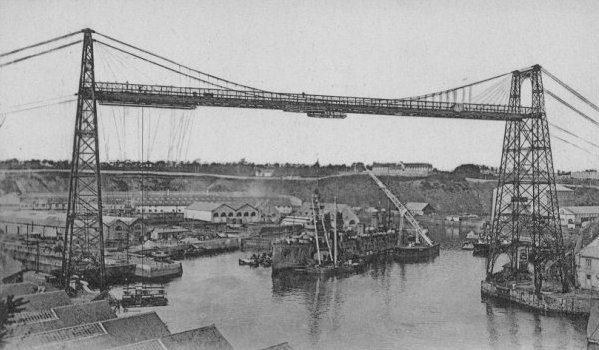
The Brest Transporter Bridge spanned the River Penfeld
Reconstructed in 1909 by Ferdinand Arnodin at Brest, this bridge was originally located at Bizerta in Tunisia. The rebuilt bridge had a span of 109 mtrs, the same span as when it was in Bizerta. It was later replaced by the Harteloire Bridge. As with the Bizerta bridge few details are available.

The gondola of Brest Transporter Bridge
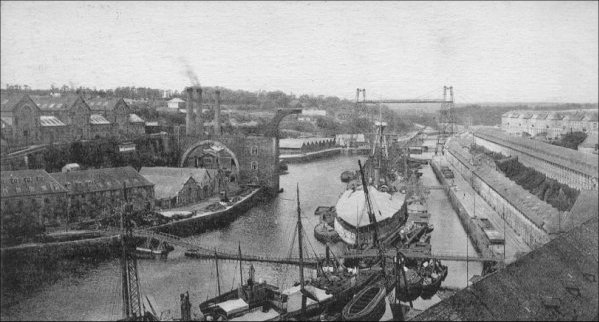
This photograph shows the French Naval Base at Brest in the foreground with the transporter bridge in the far distance.
1909 - Osten (Germany) Transporter Bridge

The Osten Transporter Bridge spans the River Oste
The River Oste, a tributary of the River Elbe, was spanned by this bridge completed in 1909 located thirty miles from Hamburg. Of cantilevered girder construction it has a span of 80 mtrs and was built by the German engineering giant of MAN (Maschinenfabrik Augsburg Nürnberg). The gondola is suspended from rigid steel girders rather than cables. In 1974 the bridge was retired from regular service and listed as a Technical Monument in 1975. The bridge is still in existence and operated occasionally.

Osten Transporter Bridge's Gondola
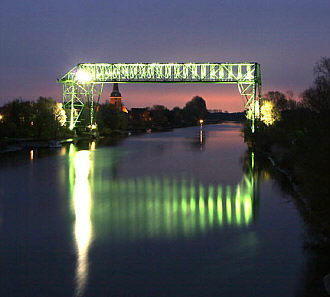
1910 - Kiel (Germany) Transporter Bridge
This is the second transporter bridge spanning the Kiel Canal and it’s associated waterways in Germany (the other being at Rendsburg… described later on in this text). Completed in 1910 it had a span of 128 mtrs and lasted until 1923 when it was demolished. Unfortunately, there are no photographs of this bridge currently available.
1910 - Bordeaux (France) Transporter Bridge

The Bordeaux Transporter Bridge spanned the River Gironde
In 1891, studies were undertaken for the bridge across the River Gironde at Bordeaux in France and it wasn’t until eighteen years later in 1909 that a bridge of the transporter type was decided upon. Construction was by Fives-Lille Cail with the first stone laid by President Armand Fallières in 1910. Only the two towers were partly built and in 1914 construction was interrupted by World War One and was not resumed afterwards. The bridge would have had a span of 1400 ft (426 mtrs), was 45 mtrs above the water and possessed a pylon height of 95 mtrs. It would have possessed the longest span of ant transporter bridge in the world at the time.
1911 - Middlesbrough Transporter Bridge
From the earliest times there have been crossings of the River Tees near what would later become Middlesbrough. A ford is believed to have been in existence opposite the settlement of Newport and it would have been used by monks and others travelling between the communities on either side of the river. In the eighteen thirties, with the advent of the coal trade and the subsequent growth in the local population, a considerable traffic sprang up between the two banks of the river and to meet this need a row-ferry service was established. This ferry continued as a private enterprise up to 1856 when a Local Act enabled the recently incorporated Middlesbrough Corporation (1853) to establish a public wharf and passage over the Tees. In 1862 the Ferry Committee gave instructions for estimates to be obtained for a steam ferryboat. “The Progress”, a shallow-draught steam ferry, built of wood by Mr. Frederick Leach and licensed to carry 139 passengers, inaugurated the steam ferry crossing of the Tees.
The Middlesbrough ferryboat "Erimus"
In 1872 Mr. Charles Smith (Manager of the Hartlepool Ironworks) submitted a scheme to the council for a Bridge, with a span of 650 feet (198 mtrs) and an airdraft of 150 feet (45.7 mtrs) above high water level. Mr. Smith's scheme for bridging the Tees was on the transporter or aerial ferry principle, and he is credited as being the originator of the concept of this type of bridge. The cost of his novel method of transportation across the Tees was placed at £31,162. The Council however decided not to adopt the bridge scheme and in 1874 commissioned "The Perseverance", the first boat to ferry horses and carts over the Tees. This ferry could carry 400 passengers and cost £2,975.
In 1884 the tender of Messrs Hepple and Co of North Shields was accepted for building the Ferry Steamer "Hugh Bell". The length of this vessel was 94 feet (28.6 mtrs), 30 feet beam (9.1 mtrs) and draught 2 feet 10 inches (1 mtr). She cost £6,050 and was licensed to carry 857 passengers. In 1901 the question of bridging the River on the present site was reconsidered and reference was made to the Transporter type of bridge which was already in successful operation abroad although it would be another five years before the idea was progressed in Middlesbrough.
The Middlesbrough ferryboat "Hugh Bell"
Subsequent ferryboats followed but on the 18th October 1906 the Council met Mon. Ferdinand Arnodin, of Chateau Neuf Sur Loire (the French engineer and pioneer of transporter bridges) and discussed with him the question of the erection of a bridge across the River Tees. They then adjourned their meeting to the 23rd October, when Mr. Wm. E. Pease, Managing Director of the Cleveland Bridge and Engineering Co Ltd and Mr. G.C. Imbault, their engineer, attended. After fully discussing the matter, the Company was appointed to act as Advising Engineers to the Corporation. The Corporation successfully promoted a Bill in Parliament authorising them to construct a transporter bridge and to discontinue the ferry. This received the Royal Assent and passed into law on 4th July 1907. Six firms responded to the invitation to tender, the successful bid being that of Sir William Arrol and Company Limited of Glasgow. The contract was signed on the 9th June 1909 for the sum of £68,026 6s 8d and the time allowed for construction and completion of the bridge was twenty-seven months.
The Middlesbrough Transporter Bridge under construction
Foundation stones of Aberdeen granite were laid on 3rd August 1910 by Lieutenant Colonel T. Gibson Pool (Mayor) and Alderman Joseph McLauchlan (the initiator of the transporter scheme). The bridge was opened on the 17th October 1911 by Prince Arthur of Connaught and it was acknowledged as a remarkable piece of engineering. The final cost of the Bridge was £84,000 and it was completed some 42 years after Charles Smith had produced his very first design for a transporter bridge at this location.
The partially completed towers of the bridge...
... and again nearer completion
The Middlesbrough Transporter Bridge gondola when it was first opened
Over ninety years later, the Transporter Bridge is still operating daily and provides an important link across the Tees. The Middlesbrough Transporter Bridge has been a symbol of the area since it was opened in 1911.
A 1950s aerial view of the bridge with the gondola in mid-traverse
The Middlesbrough transporter bridge is a total of 851 feet (259·3 mtrs) in length which makes it the longest of those remaining in the world. Its cantilever construction has three main bridge spans that give it its unique appearance. The bridge is, effectively, two almost independent structures joined at the centre by an additional span. Each half of the bridge has an “anchor” span of 140 feet (42·6 mtrs) and then cantilevers across the river some 285 feet (86·8 mtrs) from the tower leg to meet its twin from the opposite bank. The passenger gondola is suspended by steel cables and runs on a wheel and rail system approximately 160 feet (48·7 mtrs) above the River Tees.
This photograph shows the gondola traversing across the River Tees
The Middlesbrough Transporter Bridge is fully operational and provides a regular quarter-hourly service between Middlesbrough and Port Clarence for 18 hours a day. This service is interrupted from time to time for routine maintenance works, with some lengthier closures for major refurbishment. It remains the largest of the transporter bridges operating worldwide, and provides a valuable public transport service, crossing the river in two minutes.
In December 1993, the bridge was awarded the Institution of Mechanical Engineers' highest honour, the Heritage Plaque, for engineering excellence, in recognition of the Council's efforts in keeping the bridge in good working order. Its historical importance was also recognised in 1985 by its listing as a Grade 2 Listed Building and its prominence as a local landmark was further enhanced in 1993 by the installation of flood lights to illuminate it during the winter months.
The bridge illuminated by floodlights
In April 1996 local government reorganisation transferred the ownership of the bridge to Middlesbrough Council and Stockton-on-Tees Borough Council with Middlesbrough Council responsible for the day-to-day running and maintenance of the Bridge.
A return bridge ticket dated 23rd December 1950
The bridge came to media prominence when it was featured in the film "Billy Elliot" and in 2003 when it was the subject of the second television series of “Auf Wiedersehen Pet”. In the series, the bridge was dismantled and sold to a tribe of Native Americans who wanted it re-erected to convey customers across a desert gorge to their casino. After the screening of the series Middlesbrough Council were inundated by complaints from people wanting to know why the bridge had been sold and relocated… such was the quality of the computer generated graphics sequences in the programme making it’s fictitious relocation most convincing.
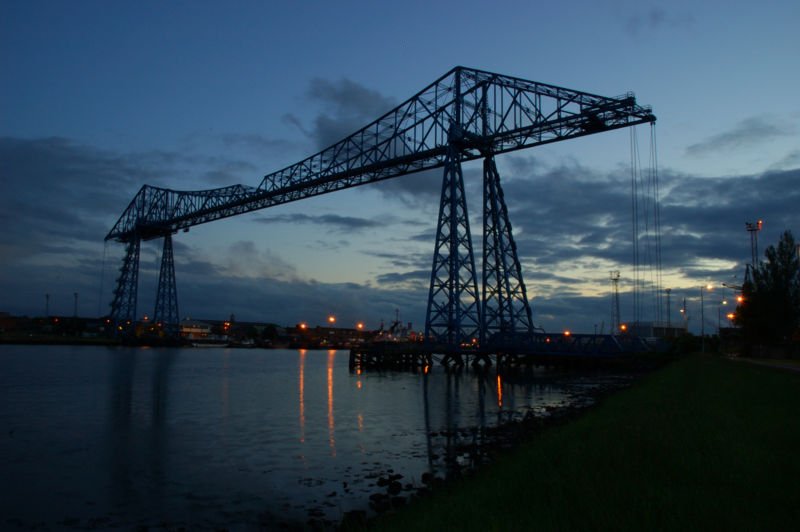
1912 - Crosfields Number Two (Bank Quay - Warrington) Transporter Bridge
As previously mentioned in the entry concerning the Crosfields Number One Bridge (note - only one "S"), the giant Crosfields manufacturing plant (later part of the Lever Brothers (Unilever) empire and their original factory, now ICI) situated at Bank Quay near Warrington in Cheshire was constructed on the banks of the tidal River Mersey as it meandered its way to Warrington town centre.
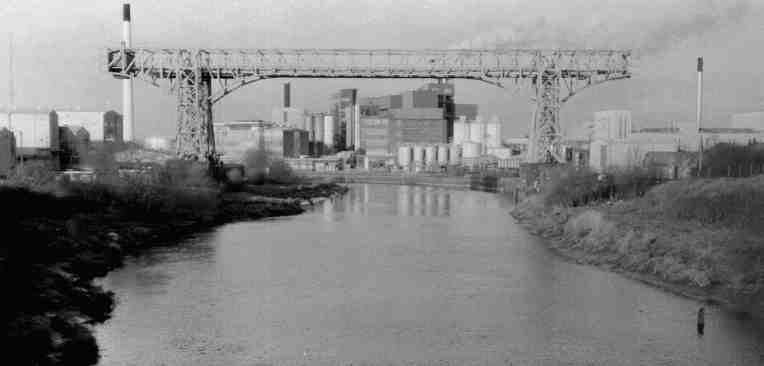
The Crosfields Number Two Transporter Bridge spans the tidal River Mersey
The earlier 1902 bridge was complemented by a second bridge built to the cantilever design with a suspended, electrically operated platform in 1912 that could accommodate road vehicles as well as railway trucks.

The gondola and support cables of the Crosfields Number Two Bridge
The earlier bridge was demolished but the 1912 bridge is still in existence. Even though, at the time of writing, it has not been used since 1964, it is complete and in need of restoration. It became a listed structure and was purchased for the sum of £10 from Unilever by Warrington Town Council who is responsible for its up-keep.
1913 - Rendsburg (Germany) Transporter Bridge
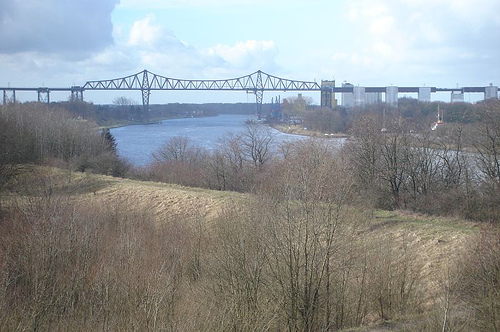
The Rendsburg Transporter Bridge spans the Keil Canal
There is located at Rendsburg in Germany, in daily use, a transporter bridge across the Kiel Canal (Nord-Ostee Kanal). This bridge is unique in that it is slung beneath a high level railway bridge and was constructed between 1911 and 1913 by Dr. H. C. Friedrich Voß. The width of the canal at the location of the bridge is 317 mtrs and allows an air draft (headroom) of 42 mtrs. Another unique feature of the bridge is a radar scanner fitted to the roof of the gondola's control cabin for giving early warning of vessels approaching the bridge along the Kiel Canal.

The Gondola of Rendsburg Transporter Bridge
(Note the radar scanner on top of the control cabin)
Further along the Kiel Canal at Kiel Harbour is another remarkable bridge. This is the Hörnbrϋcke Footbridge. It is a technological one-off… the three fielded, cable-stayed folding bridge spans the Hörn, the southern point of the Kiel Fiord. The bridge “folds” concertina fashion to allow the passage of craft through the Fjord into the old harbour at Kiel.

1914 - Buenos Aires (Argentina) Transporter Bridge
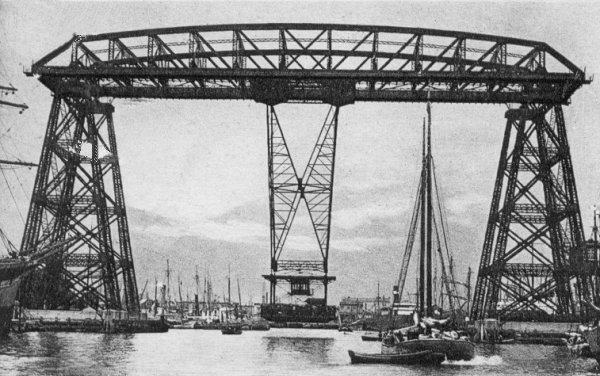
The unusual suspension of the gondola is evident in this old photograph
This little known transporter bridge was constructed in 1914 to cross the Riachuelo Waterway in Buenos Aires, Argentina. It is of the truss variety rather than the more usual cantilever type. In 1940 an interesting vertical-lift railway bridge was constructed next to it which can be seen in the background of the more recent photograph below.
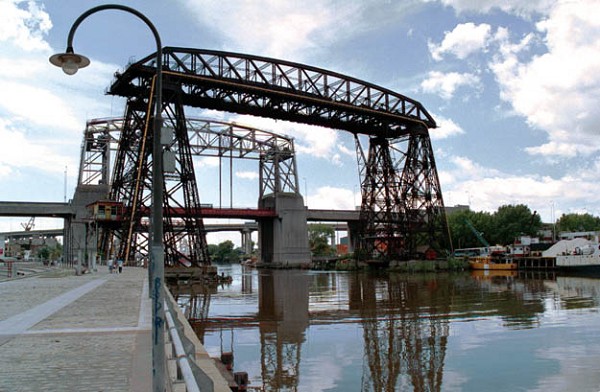
1915 - Rio de Janeiro (Brazil) Transporter Bridge
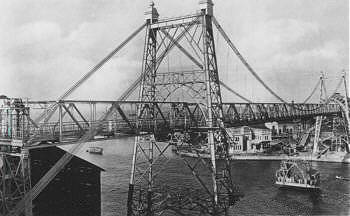
The Rio de Janeiro Transporter Bridge spanned the entrance to Guanabara Bay
Little is known of this unique (in South America anyway) bridge. It was constructed in 1915, had a span of 171 mtrs across the entrance to Guanabara Bay and was demolished in 1935. Unfortunately, no other details are available.
1933 - Chicago Skyride
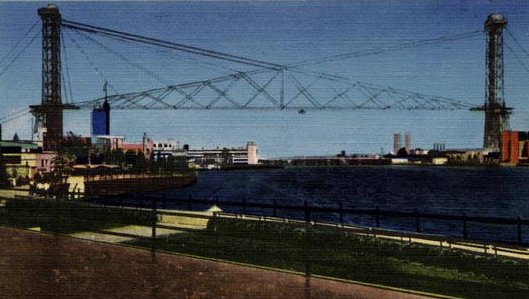
Chicago Skyride spanned the North and South Lagoons within the Exposition site
An unusual transporter bridge was constructed as part of the Chicago Century of Progress Exposition in 1933. It was a cable-stayed bridge possessing two 628 foot high steel towers to which were the cables supporting additional cables on which the gondolas ran. To gain access to the ride passengers had to ascend the towers. The trip to the tops of the towers took less than one minute in Otis Automatic High-Speed lifts. The eight Skyride lifts carried 6,000,000 passengers in the five and one-half months that the Skyride was open for in 1933 which was a new record for intensive elevator service. It was even possible to go behind the scenes and see the lift machinery in operation.
|
|
|
The two photographs above were taken from the original Skyride brochure
The bridge spanned the North and South Lagoons that were located within the exposition site. The span of the bridge was 1850 feet and the rocket ship shaped gondolas were suspended 218 feet above the water. There were ten gondolas in each weighing 6200 pounds with a capacity, 36 passengers. The gondolas operated on their own motors into and out of the loading and unloading platforms but after this traction cables pulled them as they left the trusses jutting from each tower. The steel cable overhead tracks were connected to the towers at the 210-foot level giving an unmatched observation ride in double-decked rocket shaped cars suspended beneath the support cables. The gondolas were so constructed as to give an unobstructed view in all directions. An endless traction cable drew them across the span, the ride taking about four minutes. Each of the ten gondolas was in the charge of a certified aircraft pilot. An observation platform was at the top of each tower. The gondolas had a top speed of 520 feet per minute, about 6 miles per hour. The bridge cost $1,400,000 and was dismantled in 1934... the year after its construction, when the exposition had finished.
1955 - Stalingrad (Russia) Transporter Bridge
This bridge was constructed unusually late for a transporter bridge in 1955. Its 874 mtrs span crossed the River Volga at Volgograd, Volgogradskaya Oblast, Russia making it the longest transporter bridge ever constructed. Very little is known about the bridge and there are no photographs available which is unfortunate as it has since been demolished.
1998 - Royal Victoria Dock (London) Transporter Bridge

The Royal Victoria Dock Transporter Bridge spans the dock after which it was named
A new footbridge across the Royal Victoria Dock in London has been constructed with the capability of being converted into a transporter bridge at a later date. The bridge is primarily a conventional pedestrian footbridge and when the nearby development is completed, the 200 mtrs long footbridge will be converted into a small pedestrian transporter bridge.

The bridge is still waiting for its transporter mechanism to be fitted
The bridge is of the cable-stayed variety and beneath the footbridge deck is situated a track, on which the trolley from which the gondola will be suspended, will traverse. When completed it will be the first cable-stayed transporter bridge in the world.

2003 - Erlebnisbrücke (Germany) Transporter Bridge
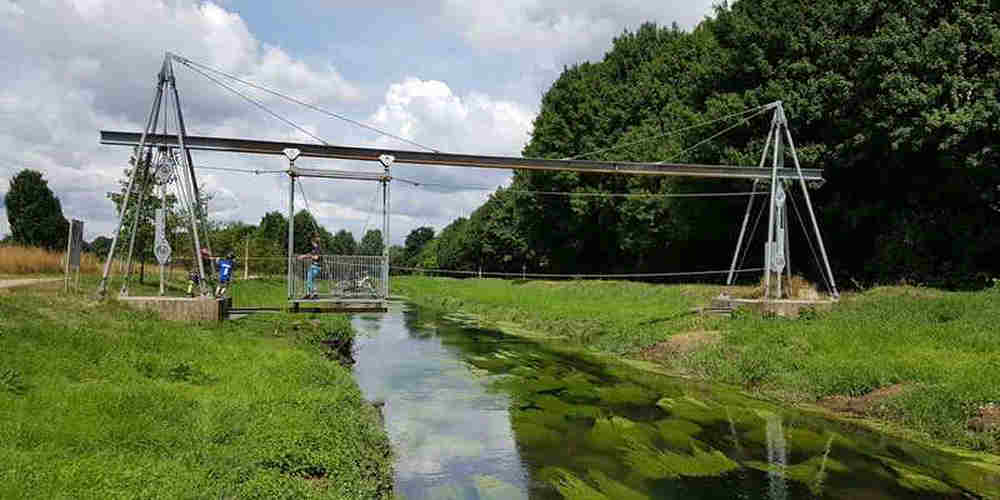
The hand-operated Erlebnisbrücke Transporter Bridge
Another cable-stayed transporter bridge constructed in 2003 is located at Erlebnisbrücke, Mönchengladbach, North Rhine-Westphalia, Germany. The bridge spans the Canal Neue Niers which connects the rivers Rhine and Meuseand. It is the smallest of the transporter bridges listed with a span of approximately eighteen metres crossing a waterway that is eight metres wide. The frame is made from steel and the gondola is 1.5 by 2.5 metres and is only capable of carrying no more that five passengers or two bicycles. The gondola is powered by hand with the passengers hauling on a rope to move the gondola. Details regarding this bridge are sparse but it appears that the bridge was constructed by Marco Baum... an architect and teacher.
2006 - Müngsten Transporter Bridge
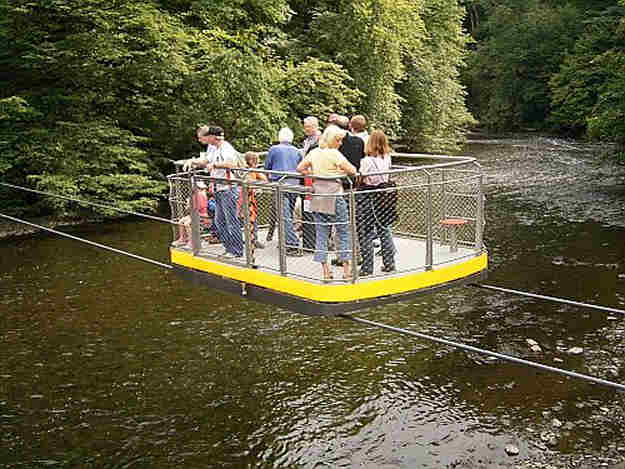
The hand operated Müngsten bridge is not a suspended gondola bridge
The Müngsten Transporter Bridge constructed in 2006 is not a transporter bridge in the accepted definition in that the gondola is not suspended from a framework. Instead it is mounted on two cables beneath the gondola. Yhe bridge spans the River Wupper in Germany and has a span of sixty one metres. Like the Erlebnisbrücke bridge it is operated by hand with a see-saw handle which moves the gondola along the fixed cables. Its carrying capacity id ten pedestrians plus bicycles and only operated during the summer months.
Today, there is an upsurge in unconventional engineering projects that manifest themselves in unusual structures such as the Falkirk Wheel boat lift in Scotland as well as various other structures, not only in the United Kingdom but throughout the world. Over a hundred years ago the designs of Mon. Ferdinand Arnodin must have been viewed in the same vain as we view these contemporary structures. Unfortunately, the technology of the transporter bridge is now virtually obsolete and they now remain curiosities used mainly as tourist attractions. As such they are a tribute to the Victorian engineers that exploited the technology of the time to cross waterways were it was inconvenient (or too expensive) to build bridges with sufficient navigable air-draft (headroom), hence the need for a transporter bridge.
My interest in Transporter Bridges was born initially out of a visit to the Crosfields Number Two Transporter Bridge across the River Mersey at Bank Quay near Warrington. A boating friend... Alec Levac took me to see the bridge and to photograph it one cold winter's morning in 1986 and it made an immediate impression on me. A few months later, I was trying out a new camera and decided to load it with Agfa Dia Direct monochrome transparency film to photograph the Runcorn-Widnes Suspension Bridge for an audio/visual presentation that I proposed to make about the bridge. I was previously aware of the existence of a transporter bridge between Runcorn and Widnes but I came across the remains of the transporter bridge piers whilst taking the photographs for the audio/visual presentation. This, combined with my previous visit to the Crosfields Bridge stimulated my interest in this type of structure. The photographs that I took were later (almost twenty years later) used in both of my books... "The Duke's Cut - The Bridgewater Canal" and "The Big Ditch - Manchester's Ship Canal". There is a website dedicated to the Crosfields Transporter Bridge which can be found at http://www.warringtontransporterbridge.co.uk.
Diarama Contents
Click on the required section below to follow links
Wyre Heal - Wirral's Local History
|
|
|
|
Updated 22/08/2020